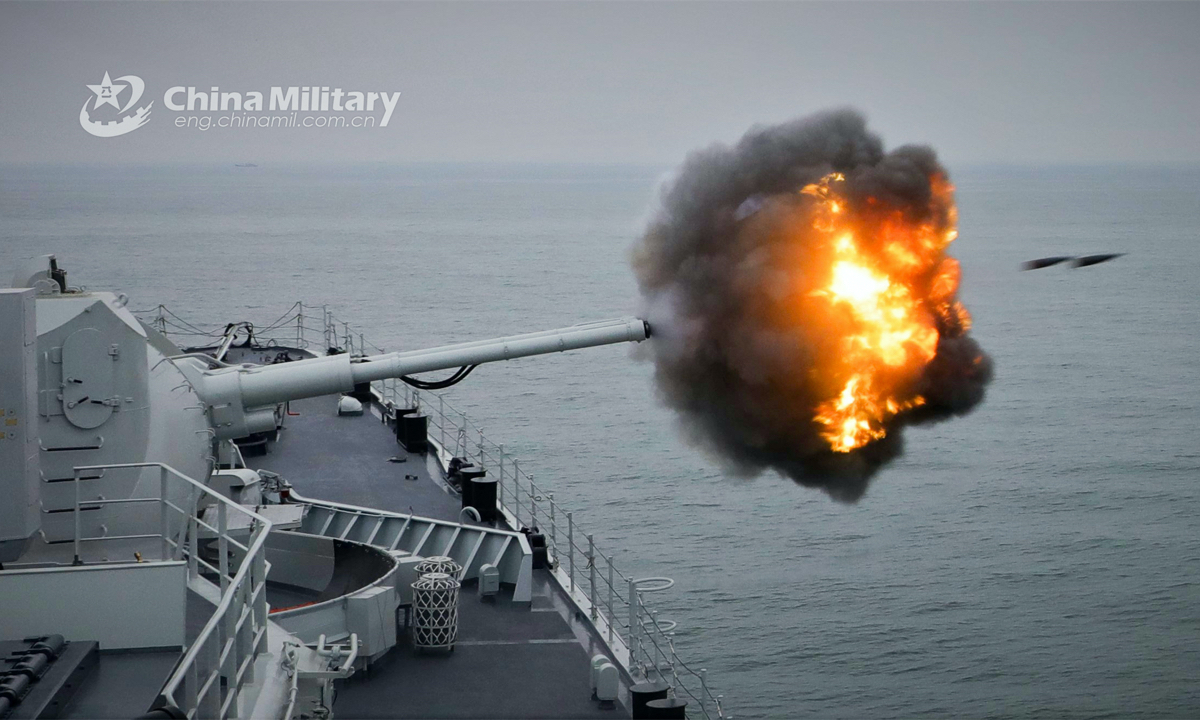
A destroyer attached to a naval destroyer flotilla under the PLA Eastern Theater Command fires its main gun at mock target during a recent live force-on-force training exercise. (eng.chinamil.com.cn/Photo by Wen Zidong)
Military tensions between China and the US have yet to see an immediate de-escalation after US Secretary of State Antony Blinken's visit to China, with both countries' warships and warplanes, including aircraft carriers, spotted operating in sensitive waters in the Taiwan Straits and the South China Sea on China's doorstep over the past few days.
If the US really wants to control risks of accidents or seek dialogue, it should stop saying one thing and doing another, and stop making military provocations around China, experts said on Saturday.
The US Navy's only forward-deployed aircraft carrier, the USS
Ronald Reagan, was operating in the South China Sea on Friday, according to a press release from the Pentagon's Defense Visual Information Distribution Service.
Scheduled to make a rare port call in Vietnam on Sunday, the
Ronald Reagan Carrier Strike Group has been operating in the South China Sea since last week after completing joint exercises with Japanese, French and Canadian ships in the East China Sea and the Philippine Sea together with the aircraft carrier USS
Nimitz in early June, media reports said.
On Wednesday, US Coast Guard cutter USCGC
Stratton made a transit in the Taiwan Straits, a move that was closely tracked and monitored by vessels of the China Coast Guard (CCG), said Gan Yu, a spokesperson at the CCG.
Also on Wednesday, the defense authority on the island of Taiwan said it spotted the PLA Navy's
Shandong aircraft carrier group when it sailed through the Taiwan Straits in a southwesterly direction into the South China Sea, according to media reports on the island.
A number of US spy planes, including a P-8A maritime patrol aircraft, an EP-3E electronic reconnaissance aircraft, an RC-135 reconnaissance aircraft and a suspected drone, operated in the South China Sea at the southern end of the Taiwan Straits on Wednesday, Chinese technology and intelligence company MizarVision said in a Weibo post, citing open-source flight data.
When the aircraft carrier
Shandong sailed through the Taiwan Straits in a northeasterly direction in late May, a US RC-135 reconnaissance aircraft intentionally intruded into the PLA carrier group's training area for reconnaissance and disturbance, and a PLA Air Force J-16 fighter jet's professional and resolute interception of the US spy plane was hyped up by the US side,
which tried to falsely blame China for the China-US military tensions and pressure China into a dialogue ahead of the Shangri-La Dialogue that was held in early June.According to reports, the aircraft carrier
Shandong sailed through the Taiwan Straits northward in late May and then returned from the same route through the Taiwan Straits southward in late June for a routine training mission, which is not related to the current situations in the Taiwan Straits or the South China Sea, a Beijing-based military expert who requested anonymity told the Global Times on Saturday.
But as a strategic platform, the carrier's movements will always serve as a deterrent force against the "Taiwan independence" secessionist forces and external interference forces, and serve as a balance against US military provocations near the island of Taiwan and in the South China Sea, the expert said.
Blinken wrapped up a two-day visit to Beijing on June 19, in which the two sides agreed to stabilize their relations and keep communication lines open. However, the US aircraft carrier, cutter and spy plane activities on China's doorsteps showed the military tensions between the two countries remained for the time being, observers said.
The US claimed it will work on stabilizing China-US ties, but at the same time continued to instigate events that raise tensions, said Li Haidong, a professor at the China Foreign Affairs University.
Li told the Global Times that the US moves, which do not respect China's sovereignty, security and interests, are dangerous, and moves like these that play with fire could again lead to a deterioration in China-US relations, and the responsibility will be for the US to bear.
Just recently, China honored a PLA Air Force unit that broke the first island chain into the Pacific Ocean several times, conducted nighttime Taiwan island encirclement flights, carried out combat patrols in the South China Sea, and expelled foreign vessels illegally sailing in Chinese waters with H-6K bombers over the past years.
The Chinese military has the capability, will and confidence to resolutely safeguard national sovereignty, security and development interests, as it has built a comprehensive system integrating land, sea, air, space, electromagnetic space and cyberspace that can deny any external interference forces on China's doorsteps, be it around the island of Taiwan or in the South China Sea, whether it involved coast guard cutters or aircraft carriers, analysts said.




